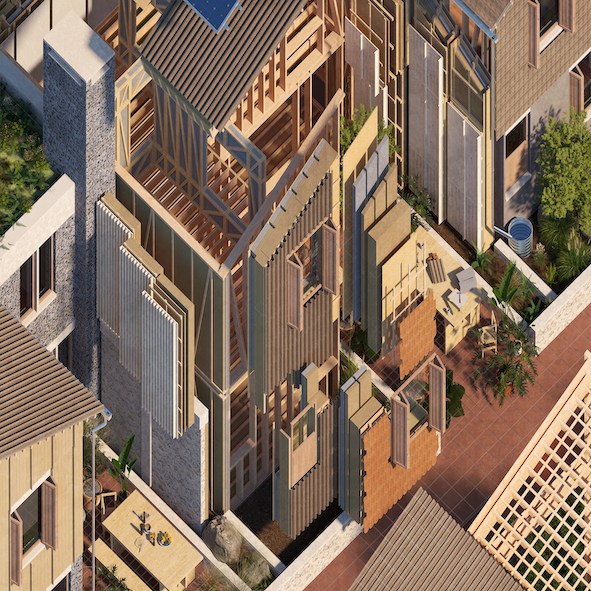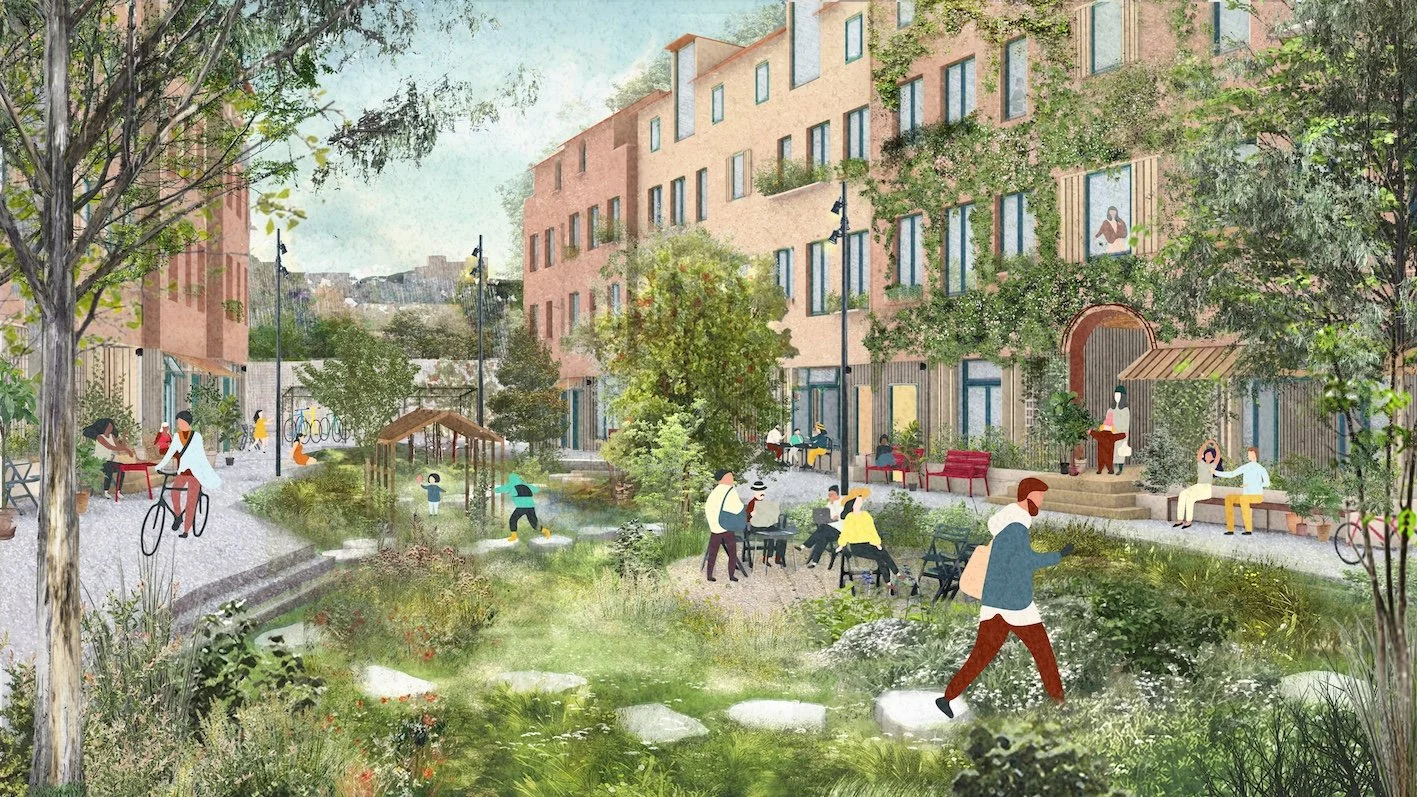We have a climate crisis, housing shortages, and increasing urban disconnection, we need a pioneering radical approach to development that puts nature and human flourishing at its core. Human Nature, led by Joanna Yarrow, are creating living, breathing ecosystems that challenge how we normally go about urban design.
"We've boxed ourselves into a corner by having the starting point that we are separate from nature," Joanna explains. Places should not just exist alongside nature, they should be fundamentally integrated with it.
Human Nature has identified three critical place typologies that could transform how we live. These are urban neighbourhoods, rural clusters, and new settlements. Their flagship project, the Phoenix in Lewes, East Sussex, demonstrates what's possible when we reimagine development.
Phoenix Project, Lewes- Green Streets- Credit Periscope
"Places aren't just buildings. They are infrastructure, streets, parks, alleyways, rivers – a collection of components that includes hardware like pavements and water systems, and software like community services."
The Phoenix project is a testament to this holistic approach. Spanning 7.9 hectares of former industrial land, it will become the UK's largest bio-based development, featuring 685 homes constructed primarily from natural materials like timber, hemp, and lime.
Biobased construction -Credit New Works
But this isn't just about sustainable construction. It's about redesigning entire lifestyles. "We want to create the optimal precondition for a better, healthy, and more sustainable way of life." This means designing neighbourhoods where car dependency becomes unnecessary, where food production is integrated, and where nature isn't an afterthought but the central organising principle.
Her background – growing up in a 64-acre working wood in Sussex – deeply influences her approach. "Nature was my playground," she recalls. This personal connection translates into a professional mission to mainstream sustainable living.
The challenge, she argues, isn't technological. "Most of this is not rocket science. Most of this has been done already. We don't need to reinvent the wheel." Instead, we need collective will and a systemic reimagining of development.
Phoenix Project, Lewes- Rain Garden- Credit Periscope
We should review the concept of “developers” to be not just extractive profit-makers, but as stewards with critical societal duty. "You are shaping people's lives for decades, generations to come. What a responsibility."
Everyone can contribute to change. "The power sits with all of us to weave this into our everyday life.” This might mean walking a different route to work, engaging with local green spaces, or challenging existing development models.
The benefits extend far beyond environmental considerations. These nature-integrated spaces promise improved mental health, community connection, and a sense of belonging that modern developments often strip away.
"Wouldn't it be wonderful, if our schools had forests instead of fences? If our walk to work included fruit trees, flowers, and bird song? If our homes and offices could breathe without us needing to open a window?"
Projects like the Phoenix prove such transformative development is possible. By demonstrating viable alternatives, Human Nature is creating blueprints for a regenerative future. We can redesign our built environment to enhance not compromise both human and natural systems.
https://humannature-places.com/
Bonus show notes: Advice for Developers to Design Better, Based on Joanna Yarrow's insights:
1. Shift Your Mindset
- Stop seeing development as unit production and profit extraction
- Become "stewards" rather than "extractors"
- Recognise that you're shaping lives for generations, not just building temporary structures
2. Embrace Holistic Design
- Don't just design buildings, design entire "places" that include:
* Infrastructure
* Streets
* Parks
* Community services
* Green spaces
- Consider the entire ecosystem, not just the physical structure
3. Prioritise Collaboration
- Practice "deep collaboration" with:
* Local communities
* Specialist architects and designers
* Environmental experts
* Interest groups
- Be transparent and open-source about your learning and processes
4. Focus on Positive Impact
- Design with three core considerations:
* Climate positive outcomes
* Nature enhancement
* Human flourishing
- Create places that inspire and enable sustainable living
5. Think Beyond Traditional Boundaries
- Consider different place typologies:
* Urban neighbourhoods
* Rural clusters
* New settlements
- Customise design to specific bioregional contexts
6. Integrate Nature Seamlessly
- Don't treat nature as an "other" or additional feature
- Centre nature in every design decision
- Create multi-sensory experiences that connect humans with natural systems
7. Enable Sustainable Lifestyles
- Design spaces that make sustainable living:
* Easy
* Attractive
* Accessible
- Reduce car dependency
- Incorporate food production
- Create green corridors and natural infrastructure
8. Engage Communities
- Run collaborative design processes
- Host community events and design festivals
- Seek input and co-creation from local residents
- Be propositional, not oppositional
9. Think Long-Term
- Stay involved beyond initial construction
- Consider how places will be lived in and managed over decades
- Create flexible, adaptable designs
10. Be Ambitious and Brave
- Challenge existing development models
- Learn from international best practices
- Don't be afraid to pioneer new approaches
As Joanna powerfully states: "We need to both inspire and enable a healthier, positive, lower impact, more sustainable way of life."
How Shall We Live?” - Human Nature’s research collaboration focusing on how to create new settlements with positive impacts - with Arup, Heatherwick Studio, White Arkitekter and others - Link herehttps://drive.google.com/file/d/134fqrlGzislmGF4wFJ8n3Zl3j-QI9bfC/view
Joanna Yarrow is the Chief Impact Officer at Human Nature, a sustainable placemaking company dedicated to designing, building, and operating places that make sustainable living easy and attractive.
Previously, Joanna served as the Global Head of Sustainable & Healthy Living at IKEA, where she led initiatives to make sustainable living affordable, attractive, and accessible worldwide. She has also held leadership roles at M&C Saatchi Group, co-founding M&C Saatchi LIFE, a strategic creative consultancy focused on mainstreaming sustainable living. She has also authored several books on sustainable living, and you might have seen her on TV too.
Photo Credit in title screen for the video: Phoenix Project, Lewes- Courtyards- Credit Carlos Peñalver
Have you got a copy of the Journal? You can now subscribe as a member of the Journal of Biophilic Design or purchase a gorgeous coffee table reference copy or PDF download of the Journal journalofbiophilicdesign.comor Amazon and Kindle.
Book tickets and join us in PERSON and LIVE STREAMED Biophilic Design Conference and you can watch on catch up! www.biophilicdesignconference.com
Credits: with thanks to George Harvey Audio Production for the calming biophilic soundscape that backs all of our podcasts.
Listen to our podcast on Audible, Amazon Music, Spotify, iTunes, YouTube and all the RSS feeds.
https://www.facebook.com/journalofbiophilicdesign/
https://twitter.com/JofBiophilicDsn
https://www.linkedin.com/company/journalofbiophilicdesign/
https://www.instagram.com/journalofbiophilicdesign
If you like this,please subscribe!


